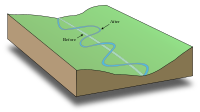
Photo from wikipedia
Abstract Stream-channel offsets are widely used for identifying strike-slip faults and estimating fault slip rates, assuming offsets result from fault slip. However, surface processes can modify and change stream channels.… Click to show full abstract
Abstract Stream-channel offsets are widely used for identifying strike-slip faults and estimating fault slip rates, assuming offsets result from fault slip. However, surface processes can modify and change stream channels. Here, we used a simple numerical model to investigate morphological evolution of stream channels due to both strike-slip fault slip and surface processes. Our results show competing effects: whereas fault slip offset stream channels, surface processes tend to modify fault offsets. Small fault offsets (a few meters) could be reconnected and straightened by new stream channels in a few hundred years or less. Over longer time, the cumulative effects of repeated fault slip and surface processes could lead to channels that are obliquely curved across the fault trace and differ from sharp and clear fault-offset stream channels. The morphological evidence of fault-offsets would be better preserved when the recurrence intervals of fault slip is shorter, and the fault zone is weaker. On the other hand, long recurrence intervals of slip events, irregular initial landforms, and complications of stream channel development such as stream capture, enhance the modification of fault-offsets of stream channels. We systematically examined the effects of major factors, including recurrence intervals of fault slip, diffusion and incision coefficients, and time-dependent variations of incision. Our results call for careful studies of surface processes when using stream-channel offsets to infer fault slip and estimate slip rates.
Journal Title: Geomorphology
Year Published: 2021
Link to full text (if available)
Share on Social Media: Sign Up to like & get
recommendations!